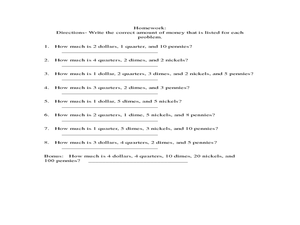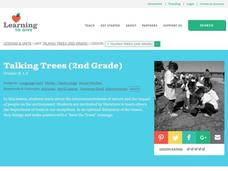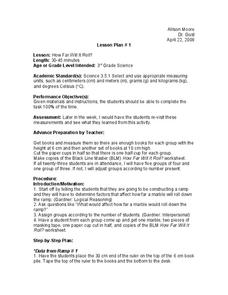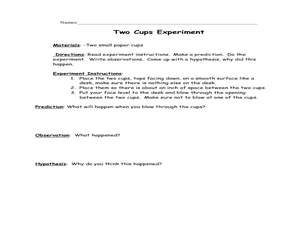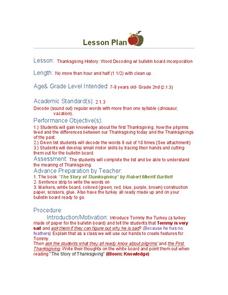Curated OER
Message in a Bottle
Sixth graders write a short story about being stranded on a deserted island. After a brief geography review of locations at various latitudes and longitudes, 6th graders draft their story about being stranded. They use sensory and...
Curated OER
The Rainbow Fish
Learners listen to The Rainbow Fish and select the correct meaning of the story from three examples presented by the teacher. They use a paper sclae to write three descriptive words about themselves.
Curated OER
The Underground Railroad
Fourth graders participate in a literature circle after reading a book about the Underground Railroad. They discuss their selected book with their literature circle group, and complete a handout about their role in the circle. Students...
Curated OER
The More Things Change
Second graders discuss change in cities over time. They view pictures of a city as it has changed over time and then compare city pictures of the past to those of a modern city today. In preparing for a guest speaker who will come and...
Curated OER
Why Do Ice Cubes Melt?
First graders investigate water properties by participating in a hands on experiment. In this ice formation lesson, 1st graders examine real ice cubes in a bowl and identify the reasons why certain cubes melt faster than others. Students...
Curated OER
Summertime Travel
Third graders write about a summer event they participated in. In this paragraph writing lesson plan, the teacher models how to write about a place they have visited. Students then write their own paragraphs. Students will point...
Curated OER
Spelling Word Flashcards
First graders draw pictures of spelling words. In this spelling lesson, 1st graders create flashcards by drawing a picture of each of the spelling words on one side and writing the actual word on the other side.
Curated OER
How Much Money Do You Have?
Second graders are given 8 world problems dealing with an assortment of coins. In this money lesson, 2nd graders determine the answers to each problem with 100% accuracy. Students complete a worksheet that is graded.
Curated OER
Then and Now
First graders investigate the past and present by analyzing a group of images. In this community history lesson, 1st graders read the story Sarah Morton's Day by Kate Walters and discuss the time frame of the story. Students create a...
Curated OER
Go Fish for Antonyms
Third graders, after reading and discussing the book, "One Fish Two Fish," by Dr. Seuss, practice matching pairs of antonyms together with an accuracy of 12 out of 15. They make flashcards in the shape of fish to study with and play a...
Curated OER
Baseball Math
First graders solve baseball-themed addition problems. Working in pairs, 1st graders drill each other on simple addition facts using baseballs. At the completion of group time, students introduce their partner and share their...
Curated OER
Introducing Linear Terminology
Ninth graders graph linear equations and inequalities in two variables and then, they write equations of lines and find and use the slope and y-intercept
of lines. They use linear equations to model real data and define to define the...
Curated OER
Standard Linear Form
Ninth graders identify and describe the x-intercept as the place where the line crosses the x-axis as it applies to football. They create their own differentiations to reinforce the distinction between the x-intercept and the...
Curated OER
Charlie and the Chocolate Factory
Fourth graders research and write an author report on Roald Dahl, including books written by him, birthplace, family life, and other information on his writing. Students read aloud chapters in the book. Students create a newspaper...
Curated OER
ReQuest and Motor Imaging with My Side of the Mountain
Fifth graders read "My Side of the Mountain." They create a pantomime using vocabulary words from the story. Students create three questions about the reading. They discuss the passage they read and act out words to help them better...
Curated OER
Social Studies: Class Citizenship Tree
Third graders discuss citizenship and the meaning of the Pledge of Allegiance. On poster board, the teacher draws a tree and students draw their citizenship ideas on paper or clip pictures from magazines and glue them to the tree.
Curated OER
Talking Trees: Earth Day
Students complete a tree poster activity to learn about Earth Day, stewardship, and the environment. In this environmental stewardship lesson, students read The Story of the Tree and discuss stewardship with trees. Students act out tree...
Curated OER
How Far Will It Roll?
Third graders investigate physics by conducting an experiment. For this gravity lesson, 3rd graders create a ramp using books and paper which they roll a marble down. Students utilize the scientific method to predict and...
Curated OER
Understanding Bernoulli's Principle
Fifth graders explain why we fly. In this space science lesson, 5th graders discuss Bernoulli's prinicple and its relation to flight.
Curated OER
Thanksgiving History
First graders decode Thanksgiving vocabulary while learning about the history of this holiday. In this Thanksgiving history lesson plan, 1st graders listen to a story, trace their hands to make turkey feathers and listen to a...
Curated OER
Dissecting Squid
Second graders explore biology by dissecting an animal. In this squid anatomy instructional activity, 2nd graders collaborate in pairs to investigate the inner body systems of a recently deceased squid. Students utilize plastic knives to...
Curated OER
Normal Distribution
Students complete problems on normal distribution equations. In this algebra lesson plan, students complete 11 problems out of their text book.
Curated OER
Making Words
Third graders spell words and define homophone. In this making words lesson, 3rd graders decipher words from letter strips in an effort to identify the "secret word". Students use a set of letters to spell different words.
Curated OER
Colors of Wildlife
Students observe wildlife animals. In this wildlife lesson, students cut out three different animals from a wildlife magazine. Then they compare the animals, verbally stating their similarities and differences.









